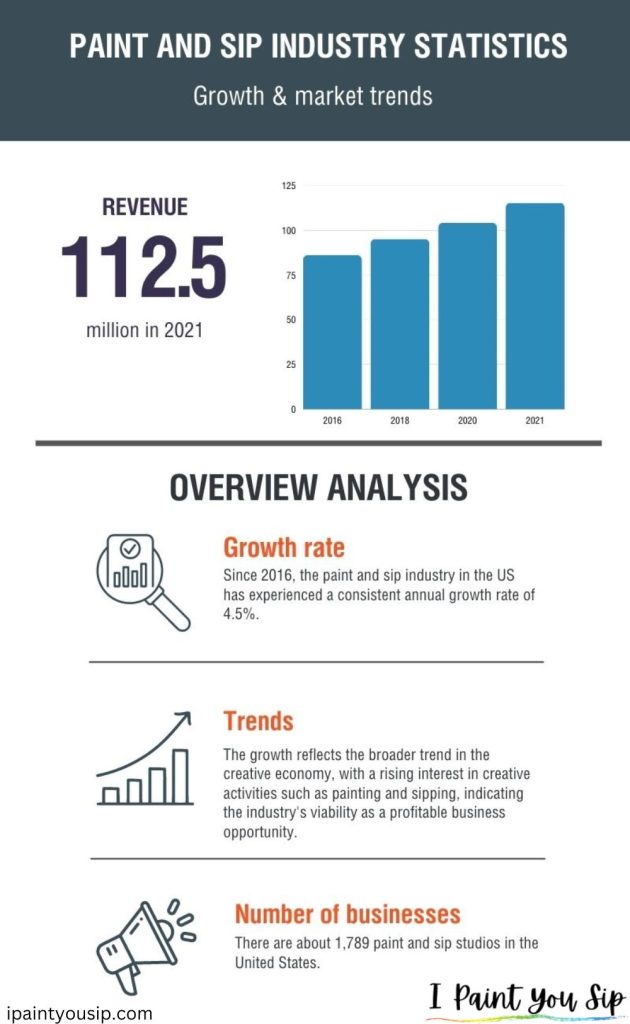The paint and sip industry has witnessed remarkable growth in recent years, displaying a continuous upward trajectory. From the emergence of social painting classes to the increasing demand for paint and sip events, the industry is experiencing a significant boom.
The following data and statistics in this article will help you gain a deeper understanding about the industry.
Let’s delve into this blog post’s latest paint and sip industry statistics to gain insights into its growth and potential.
We will also examine the key trends propelling the industry and discuss strategies for businesses to leverage them.
Sip and paint studio operators provide painting classes alongside the serving of wine and other alcoholic beverages. From 2016 to 2021, the industry experienced favorable conditions due to increased leisure time and per capita disposable income.

According to IBISWorld, the industry’s primary customer group is adults aged 20 to 64. Despite a small setback during covid era, the industry is expected to demonstrate strong performance, with projected annualized revenue growth of 4.5% to reach $115.2 million by 2021 and continue growing.
Growth and Market Trends
According to Google Trends, the interest in paint and sip activities worldwide has been growing steadily since 2010, despite a sudden dip in 2020 due to lockdowns, the industry quickly regained its growth right after that.

Overall industry growth
The paint and drink industry has experienced remarkable growth in recent years, positioning itself as a popular and thriving market. Statistics reveal a significant increase in the number of studios opening globally.
This growth can be attributed to various factors, including the rising demand for experiential activities, increased disposable income among consumers, and the growing trend of seeking creative outlets for relaxation and socializing.
The paint and sip industry in the US has experienced exponential growth over the past 15 years, going from non-existent to a value exceeding $115 million (*)
This substantial growth reflects the broader trend in the creative economy, with a rising interest in activities like painting and sipping. Given its rapid expansion, it also demonstrates the industry’s viability as a lucrative business opportunity.
What is the market size?
Over the past 15 years, the paint and sip industry in the US has experienced remarkable growth, evolving from a non-existent market to a value exceeding $115 million.
Furthermore, projections suggest that the market size of the paint and sip studios industry is set to expand by 4.1% in 2023.
Emerging trends and innovations
The industry is open to trends and innovations that shape the overall experience. One notable trend is the integration of technology into the painting process.
Some studios now offer digital painting experiences, where participants use digital brushes and screens to create their artwork. This blending of traditional painting with modern technology provides a unique twist and appeals to tech-savvy individuals.
Additionally, themed events and specialized workshops have gained popularity within the industry. Studios now organize themed nights where participants can paint specific subjects or explore different artistic styles.
This approach attracts a wider range of customers and adds variety and excitement to the overall experience.
Some innovative approaches have emerged regarding business models, such as mobile paint and sip services. These services bring the painting experience to various venues, including private parties, corporate events, and community gatherings.
The mobility aspect expands the reach of studios, allowing them to cater to a broader audience and generate additional revenue streams.
These emerging trends and innovative business models demonstrate the industry’s adaptability and ability to stay relevant in an ever-evolving market.
Financial Performance and Revenue Streams
Revenue generation
Analysis of revenue streams
This analysis may include revenue sources such as:
Painting events: the primary source of income for most studios is the revenue generated from hosting painting events, including public sessions, private parties, corporate team-building events, and fundraisers. We will explore the popularity of these events and their impact on the industry’s revenue.
Art sales: some venues offer additional revenue opportunities by selling artwork created by in-house artists or by partnering with local artists. We will discuss the potential income generated through art sales and the strategies studios employ to promote and sell artwork.
Common sources of income
Merchandise sales: many venues sell art-related merchandise, such as brushes, paint sets, aprons, and branded merchandise, to supplement their revenue.
Venue rentals: some studios rent out their space for other events, such as art workshops, exhibitions, or private gatherings, which can generate additional income.
Average profitability and profit margins
Understanding the average profitability of businesses can provide valuable insights into the industry’s financial health.
Statistics on the average profitability
Research and industry data indicate that studios can be financially lucrative ventures. According to industry reports, the average profit margins can range from 10% to 30%.
These numbers may vary depending on factors such as location, studio size, pricing strategy, and operational efficiency. It’s important to note that individual studio performance can differ significantly, with some achieving higher profitability than the average and others falling below it.
Factors influencing profit margins
When running a sip and paint business, there are several factors that can influence the profit margins of the business. Understanding these factors is crucial for studio owners and entrepreneurs looking to maximize their profitability.
Pricing strategy
The pricing structure for painting events and related services can significantly impact profit margins. Studios must find the right balance between attracting customers with competitive pricing and ensuring that prices cover expenses and generate a reasonable profit.
Operating expenses
Effective management of operating expenses plays a vital role in profitability. studios need to monitor carefully and control costs related to rent, utilities, art supplies, staffing, marketing, insurance, and permits.
Implementing cost-saving measures, negotiating favorable contracts, and optimizing operational processes can help improve profit margins.
Customer acquisition and retention
The ability to attract and retain new customers is crucial for long-term profitability.
Investing in marketing and promotion to reach the target audience, providing exceptional customer experiences, and implementing loyalty programs can contribute to a steady flow of revenue and repeat business.
Efficiency and productivity
Maximizing efficiency and productivity within the studio can positively impact profit margins. Optimizing workflows, minimizing wastage of art supplies, and effectively scheduling events and staff can reduce costs and increase revenue-generating capacity.
Market competition
The local market competition level can influence profit margins. studios operating in areas with a high concentration of businesses may need to differentiate themselves through unique offerings, exceptional customer service, and targeted marketing to maintain profitability.
By considering these factors and implementing strategies to optimize pricing, manage expenses, enhance customer experiences, and remain competitive, these studios can aim for higher profit margins and long-term financial success in the industry.
Cost breakdown and expense management
Typical costs
Operating a studio involves various expenses that must be carefully managed to ensure profitability and financial sustainability.
Understanding the typical expenses of running a studio is essential for effective cost management. Some common expenses include:
Rent and utilities: The cost of leasing a studio space and monthly utility bills constitute a significant portion of the expenses. Rent expenses can vary based on location, studio size, and local market conditions.
Art supplies and materials: Paints, canvases, brushes, easels, aprons, and other art materials are necessary for conducting painting events. These costs can vary depending on the number of events held and the size of the studio.
Staffing and payroll: Employing artists, event coordinators, and support staff involves payroll expenses, including wages, taxes, and benefits.
Marketing and advertising: Promoting the business requires allocating funds for online and offline marketing activities. This includes website development and maintenance, social media advertising, print materials, and other advertising channels.
Insurance: Liability insurance protects the studio from potential lawsuits or damages during events.
Licensing and permits: Obtaining the necessary licenses and permits to operate legally adds to the expenses. This includes business licenses, liquor license, health and safety permits, and any other local or industry-specific requirements.
Maintenance and repairs: Regular maintenance and occasional repairs of the studio space, furniture, and equipment are necessary to provide customers a comfortable and visually appealing environment.
Strategies for managing expenses
To enhance profitability and ensure long-term success, business owners can employ various strategies for cost management:
Conduct a thorough cost analysis: Regularly review and analyze all expenses to identify areas where costs can be reduced or optimized.
Negotiate favorable contracts with suppliers for better prices on art supplies, materials, and other necessary items.
Optimize staffing: Assess the number of employees required based on the studio’s workload and adjust staffing levels accordingly. Consider employing part-time or contract workers during peak periods to manage costs.
Streamline operational processes: Optimize workflows, scheduling, and event management to minimize downtime and maximize revenue-generating opportunities.
Embrace technology: Utilize technology solutions such as online booking systems, customer relationship management (CRM) tools, and accounting software to streamline operations and reduce administrative costs.
Seek cost-saving partnerships: Collaborate with local businesses for joint promotions or discounts on supplies or services.
Continuously monitor and adjust pricing: Regularly evaluate pricing strategies to ensure they cover costs, account for market conditions, and generate a reasonable profit margin.
Focus on customer retention: Implement strategies to enhance customer satisfaction and loyalty, reducing the need for extensive marketing and customer acquisition expenses.
Challenges and Opportunities
Competitive landscape
The industry has recently experienced significant growth and popularity, leading to increased competition.
Numerous studios, both independent and franchised, offer similar experiences to customers. Understanding the competitive landscape is crucial for strategic positioning and differentiation.
Business owners can employ several strategies to stand out in a competitive market. This includes offering unique themes or painting styles, providing exceptional customer service, hosting special events or collaborations, and creating a welcoming and inspiring atmosphere.
Additionally, embracing digital marketing and social media platforms can help studios reach a wider audience and build a strong online presence.
Regulatory considerations
Operating a studio involves compliance with various regulations and legal requirements.
These may include obtaining the necessary business licenses, permits, and certifications, adhering to health and safety guidelines, and ensuring compliance with alcohol licensing and serving regulations if applicable.
It is essential for business owners to stay informed about relevant regulations and seek legal guidance to ensure compliance.
Establishing clear operational policies and procedures, conducting regular staff training, and maintaining accurate records can help navigate regulatory challenges.
Building relationships with local authorities and industry associations can provide valuable support and guidance.
Growth potential and future outlook
The industry continues to show promising growth potential. Projections indicate that the industry will continue attracting diverse customers, including individuals, groups, and corporate clients seeking unique experiences.
In the United States, there are approximately 1,789 paint and sip studios, indicating a thriving industry where more individuals are embracing these studios as a fun and creative way to spend their time.
This growing number of studios signifies the significant market potential for these businesses.
Moreover, the paint and sip industry is crucial in employment, providing jobs to around 18,469 individuals nationwide. This employment figure highlights the industry’s success and its capacity for further growth, demonstrating its importance within the job market.
Around 14% of the paint and sip market comprises franchise-based businesses. This statistic underscores the attractiveness of the Paint and Sip industry for entrepreneurs seeking to establish their own businesses.
Franchises offer a proven business model and a support system, making them a viable option for aspiring business owners.
Conclusion,
Looking at the growth and market trends, the paint and sip industry has seen remarkable growth globally, driven by the rising demand for experiential activities, increased disposable income, and the desire for creative outlets.
You can check our other blogpost to learn more about the biggest paint and sip franchise companies in the US.
*image by Krakenimages/depositphotos
Jessie has a passion for bringing people together through creativity and socializing. She has organized many painting events that have left guests with lasting memories and new friendships. She’s also been to various sip events to unleash her own creativity and connect with like-minded individuals.

